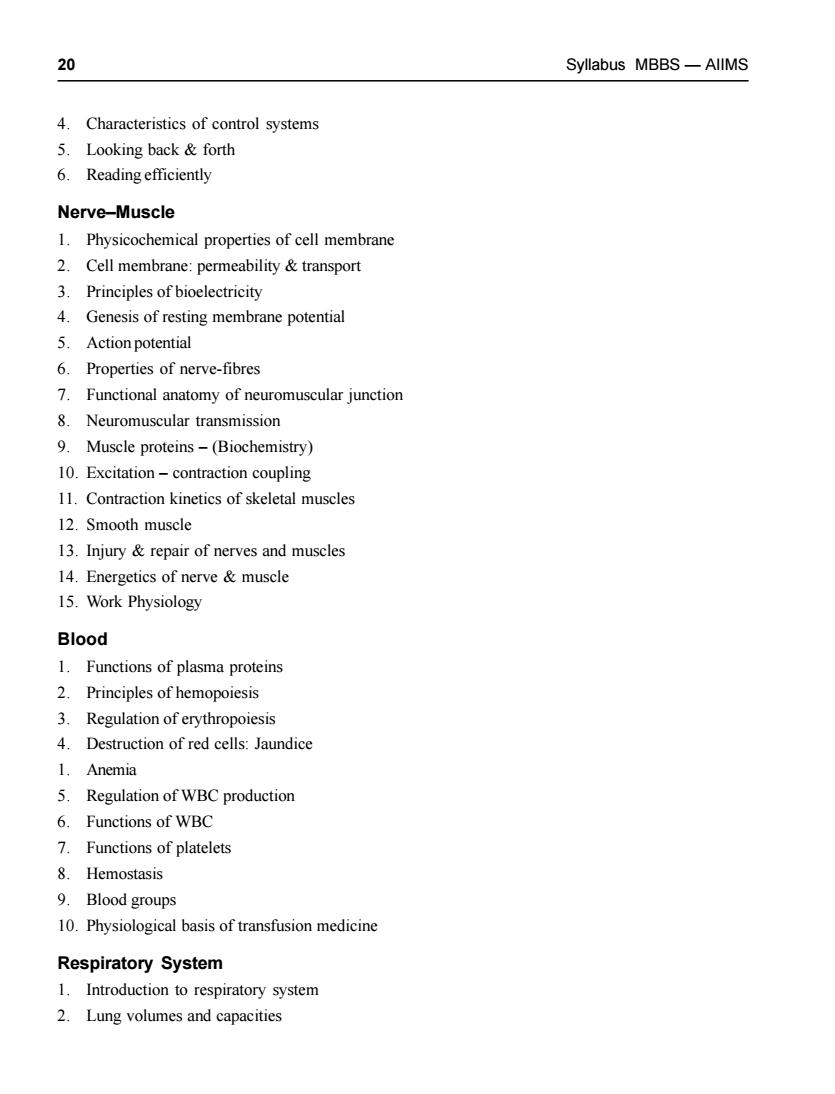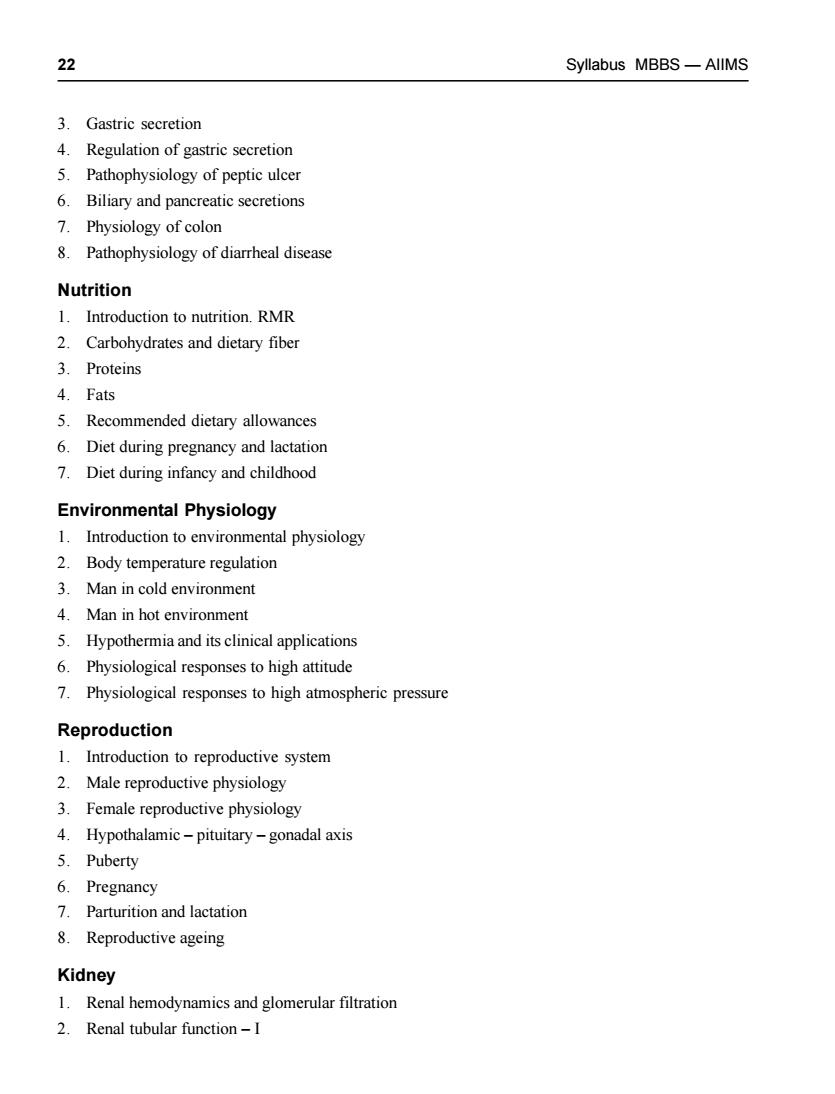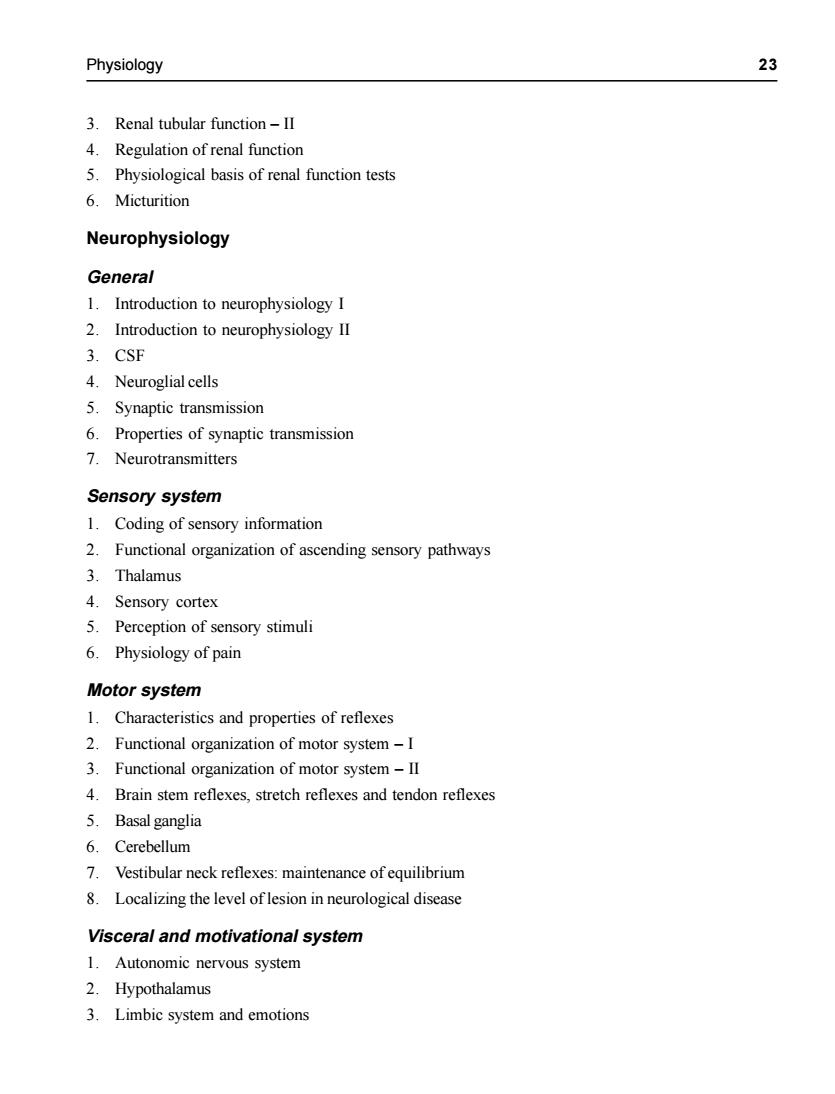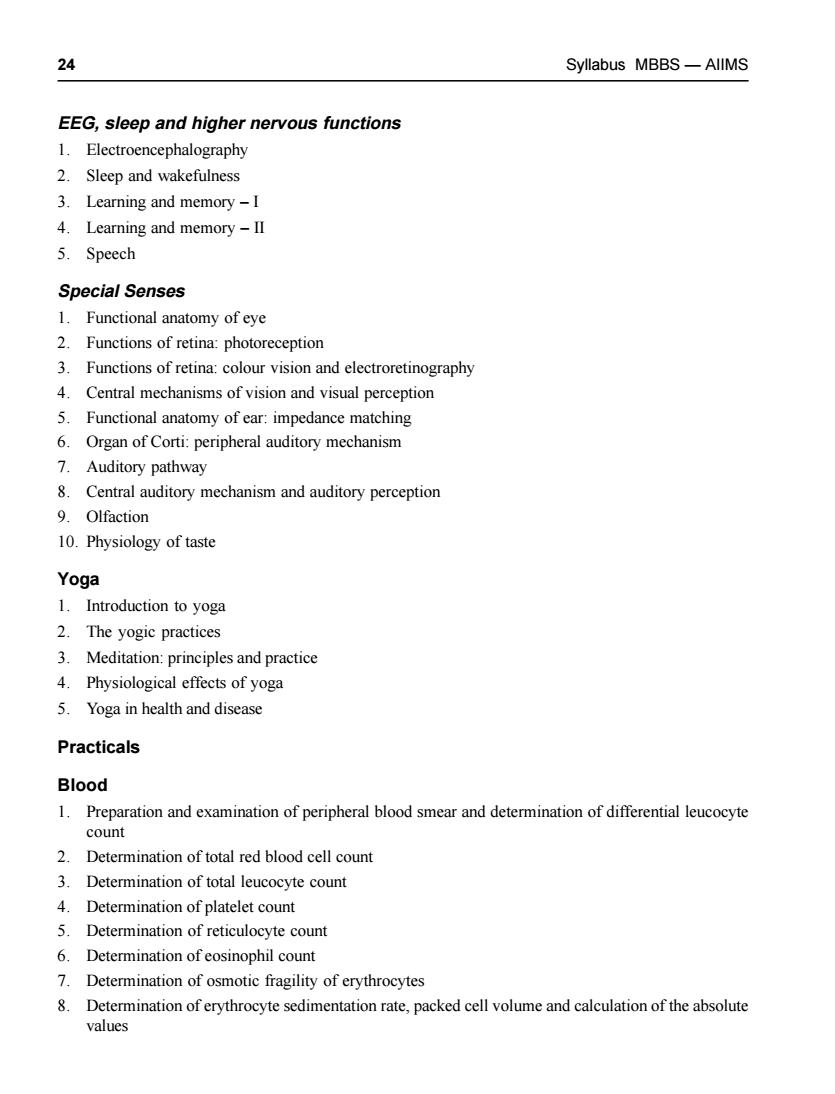
20SyllabusMBBS-AlIMS4.Characteristicsof control systems5.Lookingback&forth6.ReadingefficientlyNerve-Muscle1.Physicochemical propertiesof cell membrane2.Cellmembrane:permeability&transport3.Principles of bioelectricity4.Genesisof restingmembranepotential5.Action potential6.Propertiesof nerve-fibres7.Functional anatomyof neuromuscular junction8.Neuromusculartransmission9.Muscle proteins -(Biochemistry)10.Excitation-contraction coupling11.Contractionkineticsof skeletalmuscles12.Smoothmuscle13.Injury&repair of nervesandmuscles14.Energeticsofnerve&muscle15. Work PhysiologyBlood1.Functions ofplasmaproteins2.Principles of hemopoiesis3.Regulation of erythropoiesis4.Destruction of red cells: Jaundice1.Anemia5.RegulationofWBCproduction6.Functions ofWBC7.Functions of platelets8.Hemostasis9.Blood groups10.Physiologicalbasis oftransfusionmedicineRespiratorySystem1.Introductiontorespiratorysystem2.Lung volumes and capacities
20 Syllabus MBBS — AIIMS 4. Characteristics of control systems 5. Looking back & forth 6. Reading efficiently Nerve–Muscle 1. Physicochemical properties of cell membrane 2. Cell membrane: permeability & transport 3. Principles of bioelectricity 4. Genesis of resting membrane potential 5. Action potential 6. Properties of nerve-fibres 7. Functional anatomy of neuromuscular junction 8. Neuromuscular transmission 9. Muscle proteins – (Biochemistry) 10. Excitation – contraction coupling 11. Contraction kinetics of skeletal muscles 12. Smooth muscle 13. Injury & repair of nerves and muscles 14. Energetics of nerve & muscle 15. Work Physiology Blood 1. Functions of plasma proteins 2. Principles of hemopoiesis 3. Regulation of erythropoiesis 4. Destruction of red cells: Jaundice 1. Anemia 5. Regulation of WBC production 6. Functions of WBC 7. Functions of platelets 8. Hemostasis 9. Blood groups 10. Physiological basis of transfusion medicine Respiratory System 1. Introduction to respiratory system 2. Lung volumes and capacities

21Physiology3.Mechanicsof respiration-4.Mechanicsof respiration-II5.Compositionofrespiredair:pulmonaryventilation6.Exchange of gases inthelungs7.Ventilation-perfusionratio8.O,carriage,O,dissociation curve9.CO, carriage, CO,-dissociation curve10.Neural regulation of respiration11.Chemicalregulation of respiration12.Hypoxia, cyanosis and dyspnoea13.Special featuresofpulmonarycirculation14.ArtificialrespirationArtificialrespiration15.Therapeutic useofoxygenCardiovascularSystem1.IntroductiontoCVS2.Propertiesof cardiacmuscle3.Actionpotential and spreadof impulse intheheart4.E-Ccouplinginthemyocardium5.ECG6.Pressure changes in the heart. Cardiac cycle7.Functionalbasisofheartsoundsandmurmurs8.Neural regulation of cardiac activity9.Regulation of heart rate10.Intrinsic regulation of heart's action.Cardiac output11.Cardiac output:measurement and regulation12.Nutrition and metabolismof heart13.Exercisephysiology14.General principles of hemodynamics15.Cardiovascular reflexes16.Neural control of circulation17.Special features of cerebral circulation18.Special features ofcirculation in skeletal muscles and skinGastrointestinalSystem1.Introduction to G.I. Physiology: general organization of G.I. tract2.Masticationanddeglutition
Physiology 21 3. Mechanics of respiration – I 4. Mechanics of respiration – II 5. Composition of respired air: pulmonary ventilation 6. Exchange of gases in the lungs 7. Ventilation – perfusion ratio 8. O2 carriage, O2 –dissociation curve 9. CO2 carriage, CO2 –dissociation curve 10. Neural regulation of respiration 11. Chemical regulation of respiration 12. Hypoxia, cyanosis and dyspnoea 13. Special features of pulmonary circulation 14. Artificial respiration Artificial respiration 15. Therapeutic use of oxygen . Cardiovascular System 1. Introduction to CVS 2. Properties of cardiac muscle 3. Action potential and spread of impulse in the heart 4. E-C coupling in the myocardium 5. ECG 6. Pressure changes in the heart. Cardiac cycle 7. Functional basis of heart sounds and murmurs 8. Neural regulation of cardiac activity 9. Regulation of heart rate 10. Intrinsic regulation of heart’s action. Cardiac output 11. Cardiac output: measurement and regulation 12. Nutrition and metabolism of heart 13. Exercise physiology 14. General principles of hemodynamics 15. Cardiovascular reflexes 16. Neural control of circulation 17. Special features of cerebral circulation 18. Special features of circulation in skeletal muscles and skin Gastrointestinal System 1. Introduction to G.I. Physiology: general organization of G.I. tract 2. Mastication and deglutition

22 SyllabusMBBS-AlIMS3.Gastric secretion4.Regulation of gastric secretion5.Pathophysiology of peptic ulcer6.Biliaryand pancreatic secretions7.Physiology of colon8.Pathophysiology of diarrheal diseaseNutrition1.Introduction to nutrition.RMR2.Carbohydrates and dietary fiber3.Proteins4.Fats5.Recommendeddietaryallowances6.Diet during pregnancy and lactation7.Diet during infancy and childhoodEnvironmental Physiology1.Introduction to environmental physiology2.Body temperature regulation3.Man in cold environment4.Man in hot environment5.Hypothermiaanditsclinical applications6.Physiological responses to high attitude7.Physiological responses to high atmospheric pressureReproduction1.Introductiontoreproductivesystem2. Male reproductive physiology3. Female reproductive physiology4.Hypothalamic -pituitary-gonadal axis5.Puberty6.Pregnancy7.Parturition and lactation8.Reproductive ageingKidney1.Renal hemodynamics and glomerular filtration2.Renal tubular function -I
22 Syllabus MBBS — AIIMS 3. Gastric secretion 4. Regulation of gastric secretion 5. Pathophysiology of peptic ulcer 6. Biliary and pancreatic secretions 7. Physiology of colon 8. Pathophysiology of diarrheal disease Nutrition 1. Introduction to nutrition. RMR 2. Carbohydrates and dietary fiber 3. Proteins 4. Fats 5. Recommended dietary allowances 6. Diet during pregnancy and lactation 7. Diet during infancy and childhood Environmental Physiology 1. Introduction to environmental physiology 2. Body temperature regulation 3. Man in cold environment 4. Man in hot environment 5. Hypothermia and its clinical applications 6. Physiological responses to high attitude 7. Physiological responses to high atmospheric pressure Reproduction 1. Introduction to reproductive system 2. Male reproductive physiology 3. Female reproductive physiology 4. Hypothalamic – pituitary – gonadal axis 5. Puberty 6. Pregnancy 7. Parturition and lactation 8. Reproductive ageing Kidney 1. Renal hemodynamics and glomerular filtration 2. Renal tubular function – I

23Physiology3.Renal tubular function -II4.Regulationof renalfunction5.Physiologicalbasisofrenalfunctiontests6.MicturitionNeurophysiologyGeneral1.IntroductiontoneurophysiologyI2.Introduction to neurophysiology II3.CSF4.Neuroglial cells5.Synaptic transmission6.Properties of synaptic transmission7.NeurotransmittersSensorysystem1.Codingof sensoryinformation2.Functional organizationof ascending sensorypathways3.Thalamus4.Sensory cortex5.Perception of sensory stimuli6.Physiology of painMotorsystem1.Characteristics and properties of reflexes2.:Functional organizationofmotorsystem-I3.Functional organizationofmotorsystem-II4.Brain stem reflexes, stretch reflexes and tendon reflexes5.Basal ganglia6.Cerebellum7.Vestibular neck reflexes:maintenanceofequilibrium8.Localizingthelevel oflesion in neurological diseaseVisceralandmotivationalsystem1.Autonomic nervous system2.Hypothalamus3.Limbicsystemandemotions
Physiology 23 3. Renal tubular function – II 4. Regulation of renal function 5. Physiological basis of renal function tests 6. Micturition Neurophysiology General 1. Introduction to neurophysiology I 2. Introduction to neurophysiology II 3. CSF 4. Neuroglial cells 5. Synaptic transmission 6. Properties of synaptic transmission 7. Neurotransmitters Sensory system 1. Coding of sensory information 2. Functional organization of ascending sensory pathways 3. Thalamus 4. Sensory cortex 5. Perception of sensory stimuli 6. Physiology of pain Motor system 1. Characteristics and properties of reflexes 2. Functional organization of motor system – I 3. Functional organization of motor system – II 4. Brain stem reflexes, stretch reflexes and tendon reflexes 5. Basal ganglia 6. Cerebellum 7. Vestibular neck reflexes: maintenance of equilibrium 8. Localizing the level of lesion in neurological disease Visceral and motivational system 1. Autonomic nervous system 2. Hypothalamus 3. Limbic system and emotions

24SyllabusMBBS-AlIMSEEG,sleepandhighernervousfunctions1.Electroencephalography2.Sleepand wakefulness3.Learning and memory -I4.Learning and memory - II5.SpeechSpecial Senses1.Functional anatomy of eye2.Functions of retina:photoreception3. Functionsofretina:colourvision and electroretinography4.Centralmechanisms ofvision and visual perception5.Functional anatomy of ear: impedance matching6.Organof Corti:peripheral auditorymechanism7.Auditory pathway8.Central auditory mechanism and auditoryperception9.Olfaction10. Physiology of tasteYoga1.Introduction to yoga2.The yogic practices3.Meditation: principles and practice4.Physiological effects of yoga5.Yoga in health and diseasePracticalsBlood1.Preparation and examination of peripheral blood smear and determination of differential leucocytecount2.Determination oftotal redbloodcell count3.Determination of total leucocyte count4.Determination ofplatelet count5.Determination of reticulocyte count6.Determination of eosinophil count7.Determination of osmoticfragility of erythrocytes8.Determination of erythrocyte sedimentation rate,packed cell volume and calculation of the absolutevalues
24 Syllabus MBBS — AIIMS EEG, sleep and higher nervous functions 1. Electroencephalography 2. Sleep and wakefulness 3. Learning and memory – I 4. Learning and memory – II 5. Speech Special Senses 1. Functional anatomy of eye 2. Functions of retina: photoreception 3. Functions of retina: colour vision and electroretinography 4. Central mechanisms of vision and visual perception 5. Functional anatomy of ear: impedance matching 6. Organ of Corti: peripheral auditory mechanism 7. Auditory pathway 8. Central auditory mechanism and auditory perception 9. Olfaction 10. Physiology of taste Yoga 1. Introduction to yoga 2. The yogic practices 3. Meditation: principles and practice 4. Physiological effects of yoga 5. Yoga in health and disease Practicals Blood 1. Preparation and examination of peripheral blood smear and determination of differential leucocyte count 2. Determination of total red blood cell count 3. Determination of total leucocyte count 4. Determination of platelet count 5. Determination of reticulocyte count 6. Determination of eosinophil count 7. Determination of osmotic fragility of erythrocytes 8. Determination of erythrocyte sedimentation rate, packed cell volume and calculation of the absolute values